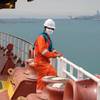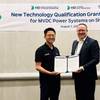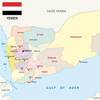One Net, Six Engines
Today, more than 90 percent of the approximately 3,000 Hong Kong fishing boats, including the pair trawlers, use Cummins Marine engines. Typical of the six pairs of steel-hulled trawlers delivered from South China yards to Hong Kong fishermen in the 12 month prior to June 2002 are the 41 by 8.5-m Haitian 4 and the Haiyi. Like most Hong Kong fishing boats, these are owner operated with Capt. Ng Wah Kwan owning the Haitian 4 and Capt. Lam Kai Chung owner and operator of her sister ship the Haiyi. Built at the Shantou Da Yang Shipyard in Shantou, Guang Dong province of South China at a cost of about $6 million each (Hong Kong dollars), the boats were being readied in Hong Kong for a trip to Taiwanese waters in early June of this year.
Each boat is powered by a single 850-hp Cummins KTA38 M0 mounted on the center line and a pair of 500 hp Cummins KTA19 M engines mounted to port and starboard. Capt. Ng explains that his family owns eight vessels with a total of 20 Cummins engines. His previous boat was a smaller Cummins-powered wooden vessel with a single 500 hp and two 425 hp engines. On his new boat, the KTA38 M0 turns a 2.22-m, 4-blade propeller while the two smaller engines have 1.93-m props. All three props have the same 1.73-m pitch and all three of the right hand rotation engines turn marine gears with a 7:1 reduction ratio with one of the outboard Hangzhou Advance Gears having a right hand rotation and the other a left hand rotation. The center Reintjes gear is a right hand rotation. This arrangement produces a 13-knot light boat speed and, together with the pair boat, easily tows a net with a mouth approximately 30 by 20 fathoms in depths from 20 to 80 fathoms at speeds around 3.5 miles per hour. Each boat has three winches including an anchor winch on the bow, a towing winch aft and a second winch on deck for hauling back the second warp when it is handed off in the final stages of recovery from the partner vessel. Each boat carries 50 tons of ice on a typical 10-day voyage with a capacity for 87 tons of boxed fish. A smaller freezer compartment has been installed forward on the main working deck for a few tons of high value fish that are sorted from the main catch by the ten person crew. Typically the Hong Kong pair trawlers will make 10 to 12-day trips in the South China sea, but each spring a two month closure is enacted for conservation purposes. For this time, some of the vessels will go to Taiwanese waters and deliver their catches to Taiwanese carrier boats. On the long run from Hong Kong to Taiwan all three engines will be operating with the Robertson Autopilot working with the Wagner steering to maintain a true course. From the wheelhouse, Capt. Ng can keep watch on his heading with the JRC Radar and of the working deck and engine room with a closed circuit televison system. The GPS is also JRC while the echo sounder is a Koden. A shrine near the engine room door honours the Budda's presence. Accommodation for the crew is in bunk rooms in the raised fo'c'sle forward on the main deck, while cabins and head for the captain and his wife are aft of the wheelhouse.
About 10 years ago, one of Hong Kong's top fishing masters took the advice of a designer to build a set of pair trawlers with only one large engine each. A nozzle would be installed to give a 30 to 40 percent increased in thrust. After he took delivery of the new boats he found that it towed the net well, but his catches were much smaller than before. He kept trying to make the new boats work for five years before finally installing two more engines in each boat which immediately improved his catches. Similar attempts at building single engine pair trawlers for Hong Kong fishermen have been equally disappointing. In recent years, the sale of older Hong Kong triple-engined pair trawlers into South China has resulted in the adoption of this practice over a growing area. The economic success of many Hong Kong business people is shown by the amount of gold they wear. The equivalent demonstration of success for a Hong Kong fisherman is more pragmatically demonstrated in the amount of stainless steel he has included in the construction of his fishing vessel. By this measure, Captains Ng and Lam are clearly successful with stainless steel covering the transom, hatch coamings, bulwarks and much of the house work. If the Hong Kong economy is faltering, clearly no one told the fishermen.











